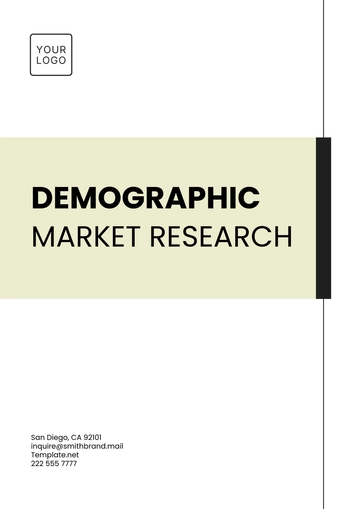Free User Experience Market Research

Summary/Introduction
As we advance toward 2050, the User Experience (UX) market is poised for transformative changes driven by technological innovations and shifting user expectations.
This research provides a thorough analysis of the UX market, detailing key trends, technological advancements, user behavior patterns, and competitive dynamics. It aims to offer businesses and stakeholders valuable insights to navigate and capitalize on the evolving UX landscape.
I. Market Overview
Current UX Landscape
The UX market has expanded significantly, propelled by technological advancements such as artificial intelligence (AI), virtual reality (VR), and augmented reality (AR). These innovations are reshaping user interactions, leading to more immersive and dynamic experiences.
Market Size and Growth Projections
Market Size (2024): $280 billion
Projected Market Size (2050): $1.2 trillion
Compound Annual Growth Rate (CAGR) (2024-2050): 6.8%
Year | Market Size ($ Billion) | CAGR (%) |
|---|---|---|
2024 | 280 | - |
2030 | 400 | 6.5% |
2040 | 800 | 6.7% |
2050 | 1,200 | 6.8% |
Key Market Drivers
Technological advancements in AI, VR, and AR
Growing demand for personalized user experiences
Increasing use of automation and data analytics
Rising focus on data privacy and security
II. Technological Trends
Artificial Intelligence (AI)
AI is expected to significantly impact UX by enabling personalized and predictive interactions. AI-driven algorithms will enhance user interfaces, making them more intuitive and responsive. Innovations include sophisticated chatbots and virtual assistants.
Virtual Reality (VR) and Augmented Reality (AR)
VR and AR will transform UX by creating immersive and interactive environments. These technologies will offer new engagement methods in sectors such as gaming, education, and e-commerce, including virtual product trials and interactive learning modules.
Internet of Things (IoT)
The expansion of IoT will result in more interconnected and cohesive user experiences. Smart home devices, wearables, and connected vehicles will enhance daily interactions, providing users with greater control and convenience through integrated systems.
III. User Behavior and Expectations
Personalization
By 2050, users will expect highly personalized experiences tailored to their preferences and behaviors. Advanced data analytics and AI will enable businesses to deliver customized interactions and content, enhancing user satisfaction.
Privacy and Security
With growing concerns about data privacy and security, users will demand greater transparency and control over their personal information. UX designs will need to integrate robust security features and clear privacy policies.
Accessibility
There will be an increased emphasis on creating accessible experiences for users with disabilities. Inclusive design practices will become standard, ensuring that digital products and services are usable by everyone.
IV. Market Segmentation
Geographic Segmentation
North America: Leading in UX innovation due to technological hubs and high consumer demand.
Europe: Focuses on data privacy and regulatory compliance, with substantial UX investments.
Asia-Pacific: Rapid growth driven by increasing digital adoption and technological advancements.
Latin America and Middle East: Emerging markets with expanding UX development opportunities.
Industry Segmentation
Technology: Major investments in UX for software, applications, and hardware.
Healthcare: Growing need for user-friendly health tech and patient interfaces.
Retail: Emphasis on improving e-commerce experiences and implementing omnichannel strategies.
Education: Expansion of digital learning platforms and interactive educational tools.
V. Competitive Landscape
Key Players
IBM: A leading UX design firm specializing in AI and VR solutions, with a focus on innovative user interfaces.
Adobe Systems: Known for its expertise in personalized user experiences and advanced data analytics, enhancing user engagement through its design tools and platforms.
Microsoft: Recognized for its contributions to accessibility and inclusive design, ensuring broad usability across its software and hardware products.
Market Share Analysis
Company | Market Share (%) |
|---|---|
IBM | 35% |
Adobe Systems | 30% |
Microsoft | 20% |
Other | 15% |
Strategic Initiatives
Investment in R&D to stay ahead of technological trends
Strategic partnerships and collaborations to expand market reach
Focus on user-centric design and customization
VI. Future Outlook and Recommendations
Emerging Opportunities
Development of new UX tools and platforms
Expansion into emerging markets and new industry sectors
Innovations in next-gen VR and AR technologies
Challenges
Adapting to evolving privacy regulations and maintaining data security
Managing the complexity of multi-channel and cross-platform user experiences
Addressing the digital divide and ensuring accessibility for all users
Recommendations
Invest in cutting-edge technologies to maintain a competitive edge
Prioritize user-centric design and personalization to boost satisfaction
Implement strong security and transparent data practices to build trust.
Contact Information
For further details and inquiries regarding this research, please contact:
[Your Company Name]
[Your Company Email]
[Your Company Address]
[Your Company Number]
[Your Company Website]
[Your Company Social Media]
[Your Email]
- 100% Customizable, free editor
- Access 1 Million+ Templates, photo’s & graphics
- Download or share as a template
- Click and replace photos, graphics, text, backgrounds
- Resize, crop, AI write & more
- Access advanced editor
Enhance your insights with the User Experience Market Research Template offered by Template.net. This customizable, downloadable, and printable template ensures a professional presentation of user experience data. Editable in our AI Editor Tool, it provides a clear framework for analyzing user interactions and preferences. Optimize your research process with this essential, easy-to-use template.





























